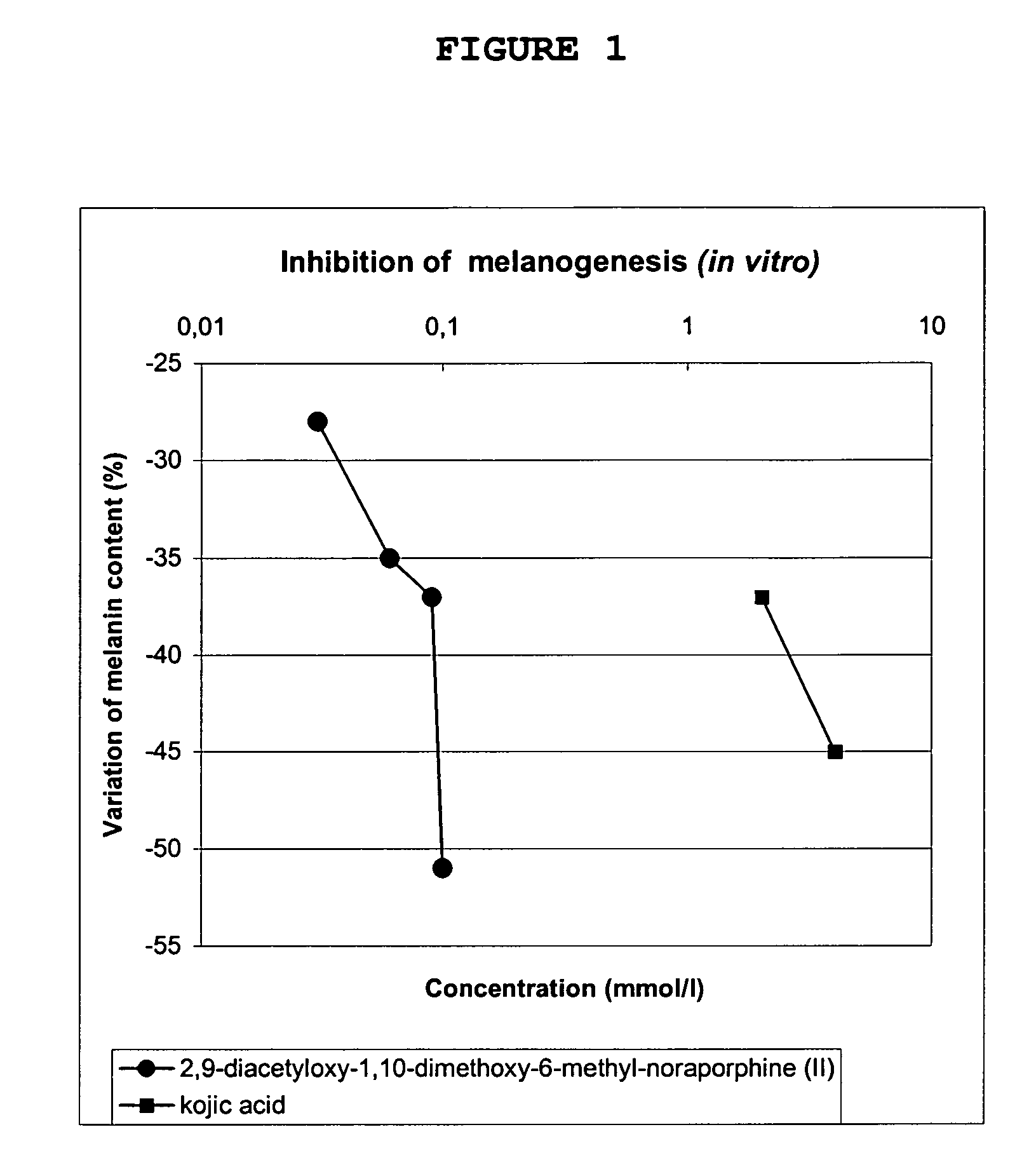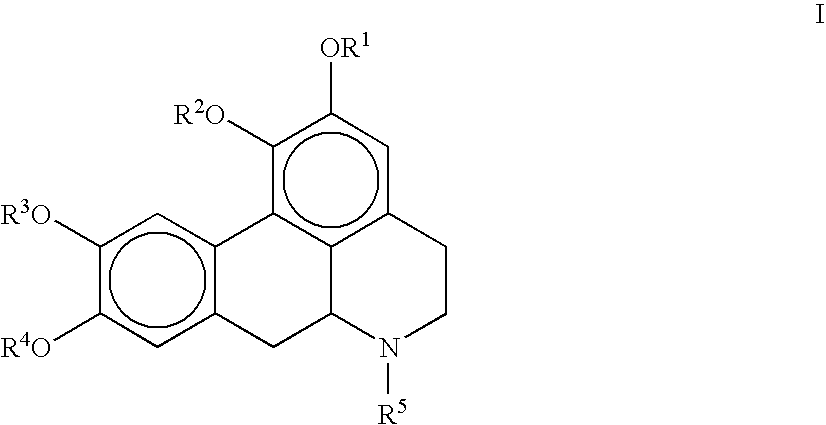Molecules derived from noraporphine
a noraporphine and molecule technology, applied in the direction of magnoliophyta medical ingredients, biocide, non-active ingredients of pharmaceuticals, etc., can solve the problems of inability to reverse the irreversible hypopigmentation effect of products, induced irritation, and rare reproduction of good results obtained in vitro on cellular cultures for use in vivo, etc., to reduce skin pigmentation and reduce signs of aging
- Summary
- Abstract
- Description
- Claims
- Application Information
AI Technical Summary
Benefits of technology
Problems solved by technology
Method used
Image
Examples
example no.1
EXAMPLE NO. 1
Synthesis of 2,9-diacetyloxy-1,10-dimethoxy-6-methyl-noraporphine (Compound II)
[0092]To a solution of 2,9-dihydroxy-1,10-dimethoxy-6-methyl-noraporphine (1.01 g; 3.09 mmol) in 20 ml of dichlorometane (DCM) are successively added, at room temperature, 3.09 equivalents of acetic anhydride (Ac2O) (900 μl; 9.5 mmol) then 1.99 equivalent of diisopropylethylamine (DIEA) (1.05 ml; 6.13 mmol). After one night of stirring at room temperature in the dark, oil ether (50 ml) and water (50 ml) are added. After extraction, the organic phase is dried on anhydrous sodium sulphate (5 g), is filtered and is evaporated. 1.15 g (2.795 mmol; 90.5% of 2,9-diacetyloxy-1,10-dimethoxy-6-methyl-noraporphine are isolated in as an odorless yellow solid after one night of drying in the desiccator.
[0093]To a solution of 2,9-dihydroxy-1,10-dimethoxy-6-methyl-noraporphine (1.01 g; 3.09 mmoles) in 20 ml of dichlorometane (DCM) are successively added, at room temperature, 3.09 equivalents of acetic anhy...
example no.5
EXAMPLE NO. 5
Inhibition of Melanin Synthesis (In Vitro)
[0104]The efficacy of the products on melanization was tested in culture of normal human melanocytes (MHN). This culture medium is conventionally used to test variations in melanin levels. The cells are incubated in the presence of the test product for 7 days while the control cells are incubated in the culture medium alone.
[0105]After 7 days, the total melanin (phaeomelanin and eumelanin) present in the cells is determined after cell lysis and dissolution in sodium hydroxide, the assay is colorimetric.
[0106]The melanin level produced under exposure to the test product at various concentrations are compared to those obtained with the control cells. The data are normalized on the protein content of the sample.
[0107]The single figure shows the variation in melanin synthesis under exposure to kojic acid for 7 days (positive control), on the one hand, and under exposure to 2,9-diacetyloxy-1,10-dimethoxy-6-methyl-noraporphine (compou...
example no.6
EXAMPLE NO. 6
Inhibition of Lipogenesis (In Vitro)
[0108]The following test is based on the fact that a cocktail from substances (hormonal messengers) induce the fibroblasts 3T3 L1 differentiation, in culture, into pre-adipocytes then in adipocytes charged with lipids.
[0109]The culture proceeds in three stages: cellular multiplication until confluence, addition of cocktail of differentiation (stage during which the initial pre-adipocytes are obtained (72 hours), then active differentiation with lipogenesis stimulation (approximately 72 hours) at the end of which apparent storage in lipidic droplets is then definitely visible under microscope.
[0110]The enzyme G-3-PDH (Glycerol-3-Phosphate deshydrogenase), essential to triglyceride synthesis is expressed very strongly during this active stage of lipidic storage.
[0111]The product to be tested is added at the second step.
[0112]After the incubation period the G-3-PDH activity is compared between the pre-adipocytes witnesses and those incub...
PUM
| Property | Measurement | Unit |
|---|---|---|
| size | aaaaa | aaaaa |
| catalytic activity | aaaaa | aaaaa |
| cell volume | aaaaa | aaaaa |
Abstract
Description
Claims
Application Information
 Login to View More
Login to View More - R&D
- Intellectual Property
- Life Sciences
- Materials
- Tech Scout
- Unparalleled Data Quality
- Higher Quality Content
- 60% Fewer Hallucinations
Browse by: Latest US Patents, China's latest patents, Technical Efficacy Thesaurus, Application Domain, Technology Topic, Popular Technical Reports.
© 2025 PatSnap. All rights reserved.Legal|Privacy policy|Modern Slavery Act Transparency Statement|Sitemap|About US| Contact US: help@patsnap.com



